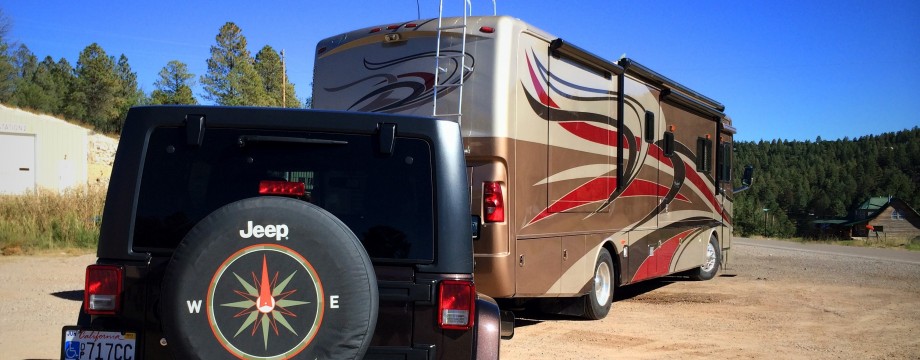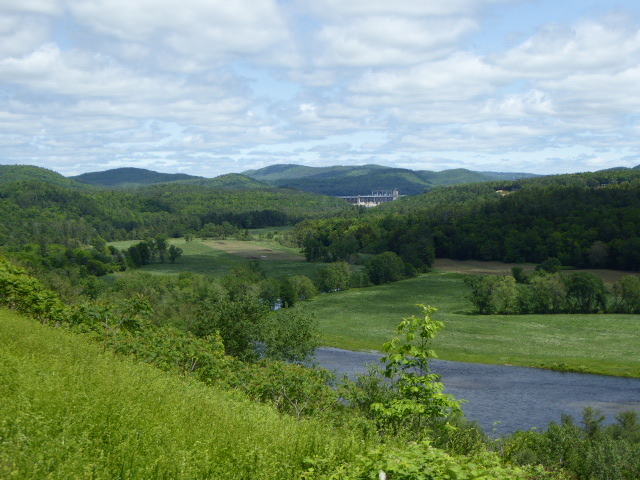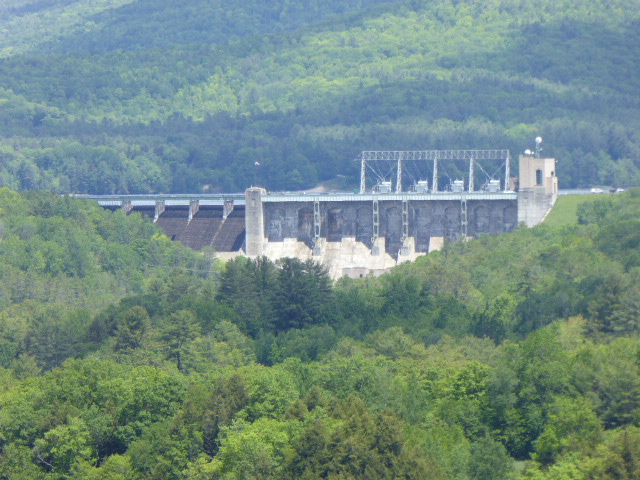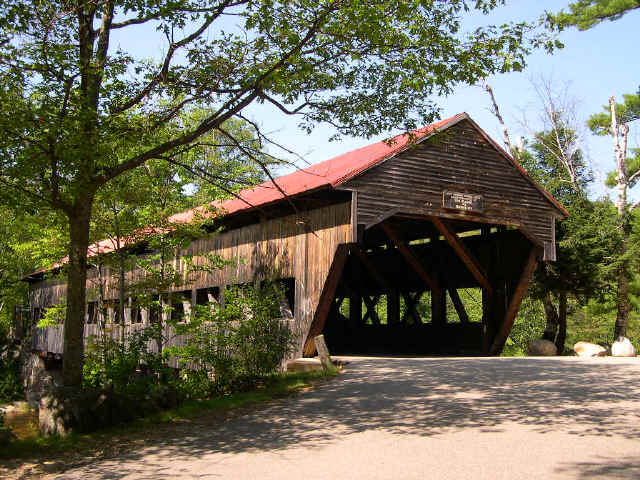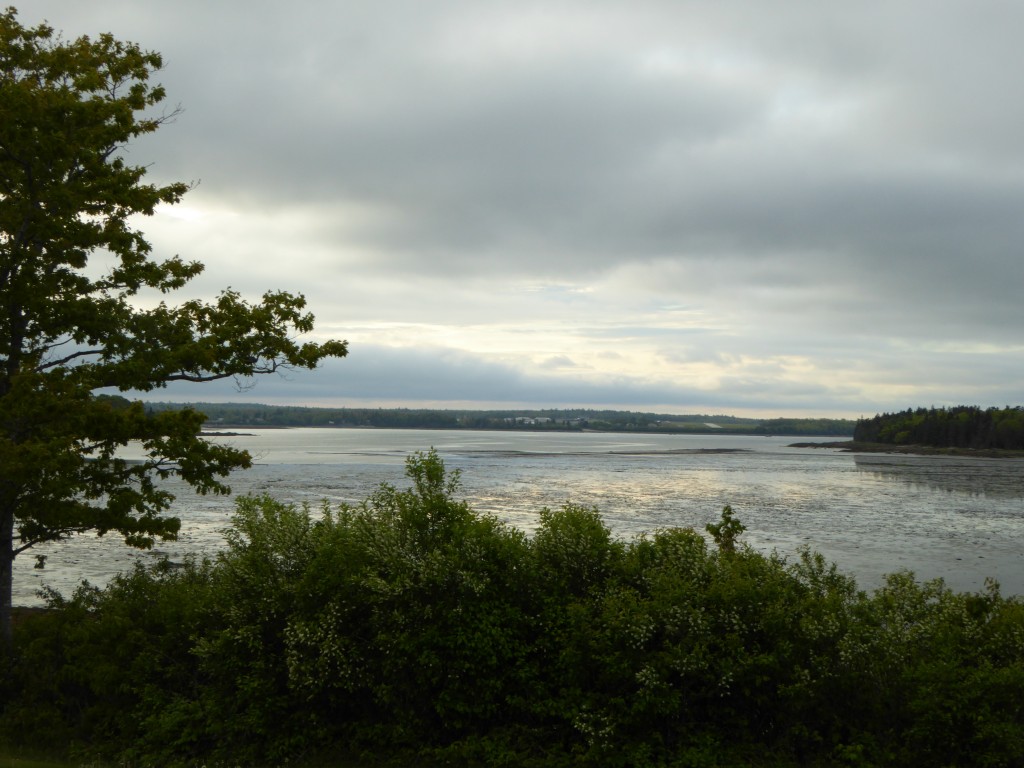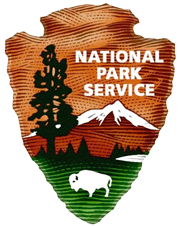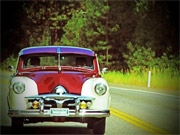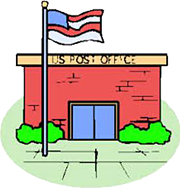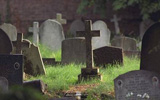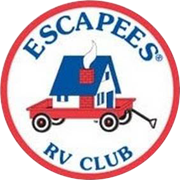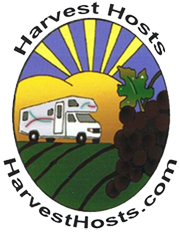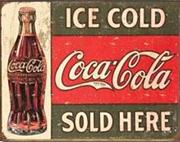JUNE 5, 2016
DRIVING THROUGH NEW HAMPSHIRE. On the second day of our drive to Bar Harbor, we traveled for miles through the beautiful state of New Hampshire. “Live free or die” is the state motto. I don’t know about that, but the scenery in New Hampshire is definitely “to die for.” Here are some photos I took from a scenic view point along the road.
COMERFORD DAM. In the top image, you can barely see the Comerford Dam. Below, is a photo of the dam taken with a long lens. It’s a concrete dam in the Fifteen Mile Falls on the Connecticut River, on the border between Vermont and New Hampshire. The reservoir behind the dam has a surface area of 1,100 acres. The discharge capacity of the dam “at full pond” would be 99,000 cubic feet of water per second. Wow! The powerhouse contains four turbines, with a combined rating of 217,000 horsepower, which is enough to power 163,000 homes. Hydroelectricity powers about 5 percent of New England’s power needs.

Typical New Hampshire countryside scene. Lush green trees and hillsides, with a farmhouse and barn across the river.
COVERED BRIDGES. Covered bridges are common in New Hampshire. American bridge builders began covering their wooden spans in the early 19th century to protect them from the harsh weather. Historically, each bridge had design elements specific to its region. Those built in farming communities were wide enough and tall enough to accommodate wagons loaded with hay. Those leading into towns had the added feature of pedestrian walkways. All the covered bridges were more than just river crossings. Fishermen cast their lines beneath the spans, children used them as platforms for diving into the water and birds nested in the rafters. Social dances were sometimes held beneath their roofs.

We stopped for a couple of nights in the tiny mountain village of Hanover, Maine. We’re about as geographically distant from home in San Diego as we could be, while still in the contiguous United States.
HANOVER, MAINE. For our final overnight stay on the road to Bar Harbor, we stopped in the tiny mountain village of Hanover, Maine. It’s situated on old U.S. Route 2, between the White Mountain National Forest to the south and Maine’s tallest mountains to the north. Only about 200 folks call this place home, but apparently it’s alive with activity during the winter because of nearby local ski resorts. This is not the town of Hanover where Dartmouth College is located. That one is in New Hampshire.
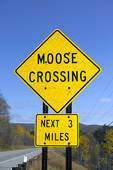 I DIDN’T SEE ANY MOOSE. Lots of “Moose Crossing” signs are posted along the road in this part of Maine. I looked around carefully the whole time we were here, but I didn’t see even one of ’em!. Reminiscent of my search for alligators in Alabama where…you guessed it, there are lots of signs warning about alligators. Oh, well. I bet once we get to the coast in Bar Harbor I won’t have any trouble finding a lobster! You can take that to the bank.
I DIDN’T SEE ANY MOOSE. Lots of “Moose Crossing” signs are posted along the road in this part of Maine. I looked around carefully the whole time we were here, but I didn’t see even one of ’em!. Reminiscent of my search for alligators in Alabama where…you guessed it, there are lots of signs warning about alligators. Oh, well. I bet once we get to the coast in Bar Harbor I won’t have any trouble finding a lobster! You can take that to the bank.
THE LAST 200 MILES TO BAR HARBOR. Day 3 of our final drive into Bar Harbor dawned bright and sunny…a great day for a drive in New England! What a treat this is. We’ve enjoyed our entire Adventure for the last 2 years, but this is really the destination we’ve been dreaming about much of the time. And we’ve got the entire Summer to explore and enjoy the east coast. We’re lucky and we know it.
WHAT’S FOR LUNCH? We left our campsite about 11 am, which seems to be our usual departure time no matter what our intentions are. The roads were narrow with lots of turns and curves most of the way. So the trip took about 6 hours, including our stop at a country roadhouse for a leisurely lunch. And what did I select from the menu? You guessed it: Yankee Pot Roast, the essence of the New England kitchen. Thumb through any New England cookbook from the last 100 years and you’ll be hard-pressed to find one without a recipe for savory Yankee pot roast. It’s comfort food at its best, and I wasn’t disappointed.
SPECTACULAR SCENERY. Day after day I’ve been commenting on the scenery and today won’t be any different. I didn’t get a chance to take more than a few pictures because there weren’t many places to stop along the way. (When New England was designed, big rig motor-homes weren’t a consideration.) So without many photos to show you, I’ll do my best to paint a picture with words. Just imagine that you’re in the front seat of our motorhome, looking out the Greyhound-bus-size windshield.
A VIEW FROM THE BUS: As the trees clear, we approach a small town…not much more than a clearing in the forest along the narrow road called Highway 1. On our left is a little roadside cemetery on a hill…a very common sight in New England. Maybe 50 markers and headstones. A few of those desktop-size American flags and some flowers. Nobody is visiting, and the road leading to the entrance gate is overgrown with weeds. Most of the ancestors appear to have been forgotten.
THE TOWN CHURCH. Past the cemetery we see the town’s Congregational Church. It’s on Main Street. It’s probably been standing in the same spot for the last 200 years. It’s white. The churches are always white in these small towns. They were erected in the eighteenth and nineteenth centuries by local builders and occasionally by itinerant master carpenters. There were no trained architects in America at the time, so the inspiration for these buildings came from traditional designs and from pattern books.
As we proceed, I notice several types of trees. Some are evergreen pines and others are ancient-looking birch trees with thick trunks and white bark. There are also some with dark red leaves, like ornamental plums. I imagine by Thanksgiving these trees in concert will be a riot of colors.
SHEEP IN A PASTURE. There was only one stop light on Main Street. We’re on our way again. A little pasture just outside town is home to a small flock of sheep and a few ponies. The ponies are shedding their winter coats and they look pretty ragged. There are cottages now, on both sides of the road. They are small, grey in color and rather weathered. Smoke drifts skyward from a chimney. It’s late afternoon and already brisk. By nightfall it’ll be in the 40’s, so it’s not too soon to get the fire started. When I slide open the driver’s window I sense the distinctive salt sea air. We cross a bridge over an inlet and see a dozen small boats moored offshore, bobbing in the choppy water with whitecaps in the distance. The water is indigo blue…the whitecaps look like miniature snow covered mountain tops. It’s absolutely beautiful here.
IN MAINE, A LOBSTER IS A LOBSTAH. Now a few antique shops and some lobster pounds (lobster shacks), with huge steaming cauldrons out front. The lobsters they sell are so fresh they were still in the ocean when you woke up this morning. Buy ’em live to take home or they’ll cook ’em in those cauldrons for you right on the spot. Pick the one you want from the seawater tank. Then all you need is some fresh corn on the cob, lots of drawn butter, and a bunch of paper towels and bibs. But be careful…they’re still really hot when they arrive at your table! They’ll show you how to eat the things if you ask. It’s a delightfully tasty mess! The last time I ate at a lobster pound in Maine was almost 50 years ago and I still remember it well. Can’t wait ’til tomorrow.
OUR CAMPSITE IS GREAT. And just another mile down the road is the RV park where we’re staying. Mt. Desert Narrows is the name of the place. It’s right on the water at Hadley Point and only 6 miles from Acadia National Park. The sites aren’t lined up parking-lot-style like so many RV parks. They’re scattered on the grass under established trees with wide spreading branches. Each has a sturdy picnic table and a large fire pit. The general store sells some groceries, supplies and firewood. Kayaks and canoes are at the water’s edge if you’re brave enough to venture into the chilly water.
SUNSET FROM OUR BUS. We watch the setting sun from the comfort of our home on wheels. The weather forecast for tomorrow is good and there is a lot to see. It will be a good day. Our cameras will get a workout and we’ll have lots of pictures and stories to share with you soon.
JOIN US AGAIN. OUR ADVENTURE CONTINUES.


